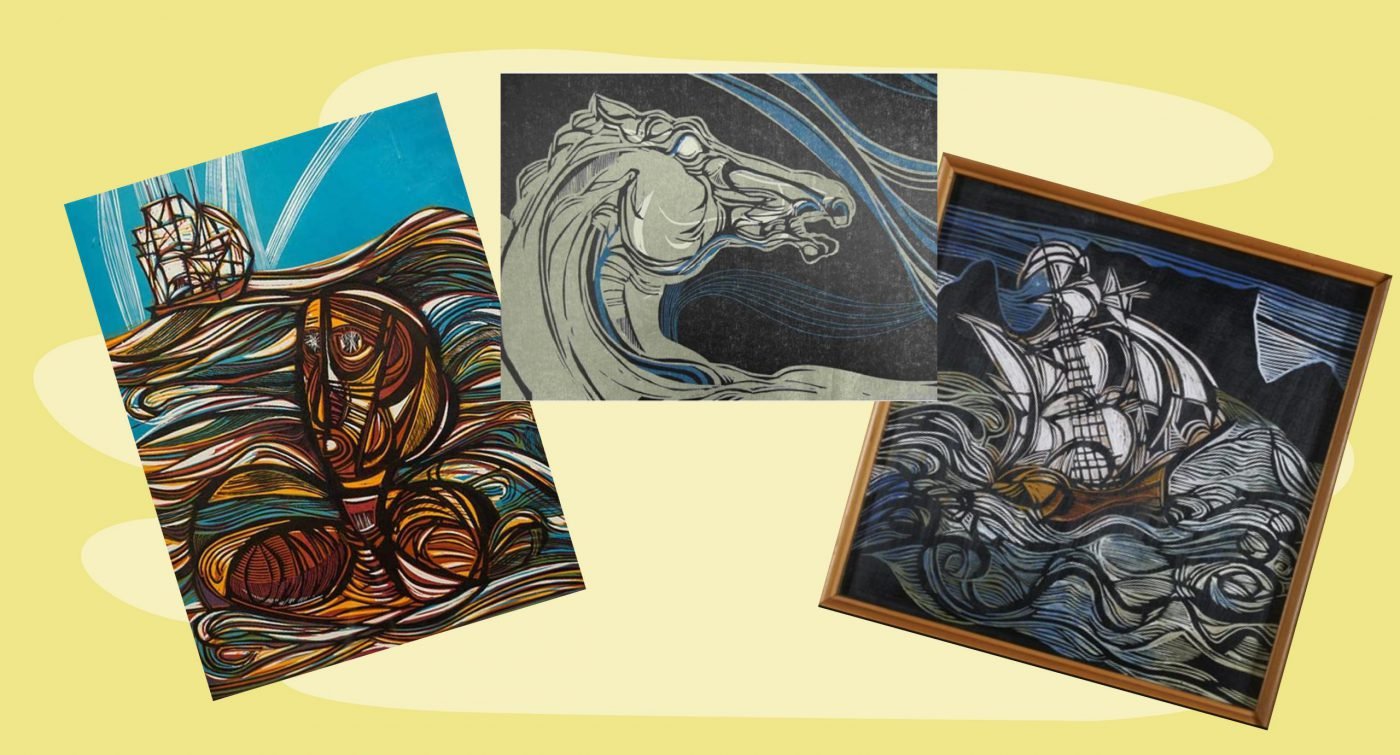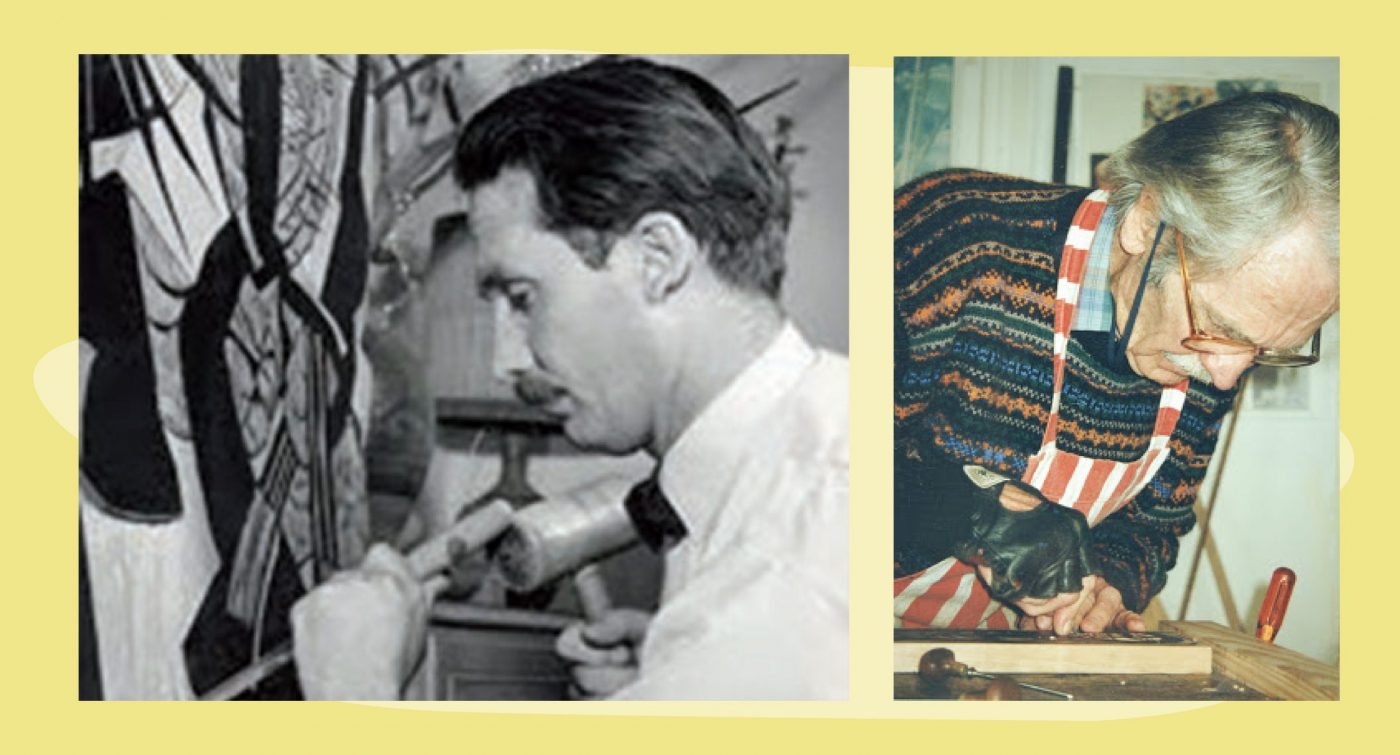No products in the basket.
Art History
Who was South African Artist Cecil Skotnes?
South African Art History: Cecil Skotnes
Hi, I am artist Lillian Gray, and I have someone you need to meet. South African artist Cecil Skotnes.
Cecil Skotnes – 1926 – 2009
When I think of Cecil Skotnes work, I think, high contrast, bold lines combined with thin ones, monochrome colours and an African story captured forever.
What I love about Skotnes is that he was loved as a teacher and an artist throughout his life, freely sharing his knowledge. As an artist and teacher myself, this really resonates with me.
Cecil Skotnes (1 June 1926 – 4 April 2009) was a South African artist known especially for his painted and incised wooden panels, striking woodblock prints, public murals, tapestries and sculpture, and who pioneered a way of producing art that used earth pigments and indigenous wood to construct visual stories about the African past. He was the cultural officer at the influential Polly Street Art Centre. Among his best-known works are The assassination of Shaka (1973) print portfolio and his twenty-four large incised panels installed at the 1820 Settlers monument in Grahamstown.

Cecil Skotnes’s heritage
Let’s get to know Cecil Skotnes a little bit better. First let’s look at Skotnes’s heritage. Cecil’s dad was from Norway, that’s really far up north and super cold, back in the day this is where Vikings lived. Cecil’s dad traveled to Canada and there he met the love of his life, Florence They married and decided that they’d like to become missionaries in Africa. Little Cecil was their fourth child and born in East London, South Africa but he was raised most of his life in Johannesburg.
Cecil Skotnes’ childhood
As a little boy Cecil loved drawing and painting and he was often commended at school for his creativity, but he also loved fishing and one of his favourite childhood memories was riding a donkey to school.

His first career
After finishing school Cecil worked for some months in a draftsman office, drawing house plans and various mechanical drawings. I’d like to imagine that this work drawing up plans really gave Cecil a good understanding of line, line quality and composition; and later on we see this feature in his work.


Cecil Skotnes during World War II
But then World War two happened and Cecil decided to join the South African army. In 1944 he was sent to Egypt to go and fight and he loved traveling and seeing all the various cultures and Egyptian art. Later he was sent to Italy to go and fight, and there, Cecil fell in love with Renaissance art.
After the war
After the war Cecil didn’t want to leave Florence, all he wanted to do was walk around the beautiful galleries and the beautiful architecture, studying the Renaissance art – he almost never came back to South Africa. Skotnes went to the Santa Maria Delle Grazie to see Leonardo da Vinci’s Last Supper. The visit was to be an almost mystical experience. When he arrived at the site of the monastery he found only one wall of a refectory standing bolstered by sandbags to protect the famous painting that has miraculously survived the bombing of Milan. This scene, and the wonder that the painting was saved, remain imprinted on his mind and he vowed he would come back to see this great artwork.

Important differences between Africa and Europe.
Cecil noticed a few important differences between Africa and Europe: one of his main observations was that history was visible in Europe, everywhere you went you saw old architecture old statues, you were confronted with the stories of the past, in Africa at the time history was still very hidden; another important difference that he noticed was the difference in space – in Africa the space was endless and vast, in Europe everybody was living on top of each other and it was almost claustrophobic. But eventually Cecil’s parents said “Cecil, stop traveling come back here and get a degree”.
So, Cecil came back to South Africa, back to Johannesburg and studied at the University of Witwatersrand completing a Bachelor’s in Fine Arts Degree in 1950. He met the love of his life Thelma at the time and they got married in 1951. They, together, decided to return to Europe where Thelma was from and settled in London. Now, one of my favourite things in London is all the amazing museums, they have some of the best museums in the world, and there are beautiful artifacts from all over on display. Cecil loved looking at the Egyptian, Assyrian and pre-classical Greek art, however there was one section of the museum that fascinated him and he kept on going back – and that section that was drawing Cecil back, was from Africa.
Back to Africa
Cecil may have well stayed in Europe, were it not for the section in the museum, but instead he was drawn back to Africa, and like his father many years before him, he made South Africa his permanent home. Back in South Africa he decides to swop his oil painting for woodcut printing, Cecil has a definite goal, he decides that he is going to develop a style that is uniquely South African. He also decides to make the neglected South African stories and histories visible, by telling them through his art. Now, being prone to out-of-the-box thinking, Cecil also didn’t just do woodcut printmaking the normal way.
Cecil Skotnes’s unique style
Normally you would cut your woodblock, engrave out the picture and then put ink on the block, and print that on a piece of paper, and then you can make lots and lots of prints. But Cecil didn’t do this, Cecil decided to only carve his pictures on indigenous wood, meaning wood from trees that are native to South Africa, and he loved carving out the picture so much that he decided not to print that on a piece of paper but to make the actual woodblock the artwork and then he would rub in pigments and oils onto the woodcut.

King Shaka
One of his first big successful artworks was that of king Shaka. Cecil decided to tell the story of Shaka Zulu and depict him as a hero, almost comparing him to the way the Greeks depicted Zeus. Now, the South African Government didn’t like this at all, and Cecil’s artwork created quite a stir, people were outraged, how can you have a black hero compared to the god Zeus.

Skotnes’s legacy
Cecil really started contemplating the question his parents always asked him “what legacy will you leave behind”, what will people remember about you once you are dead.
Cecil answered this question with two very determined goals: number one, was to change the way we remember our South African history; and number two, was to change the lives of others.
Polly Street Art Centre
Cecil accepted a post at the cultural recreation office of the non-European Affairs Department in Johannesburg. His major task in this position was to run The Polly Street Centre which was concerned with both education and recreational activities for black adults and children. They seemed to host choirs and bands, there was boxing judo and some ballroom dancing, but when he saw started his job there was only one art student enrolled. Yet today as a result of Cecil’s role in the centre, Polly Street is only remembered as an art school.

As the director of Polly Street he traveled between the city and the townships where he facilitated many cultural activities. Much of his work happened after hours when adults were free from work to undertake leisure activities. While he carried out this work, as part of his job, his own interest and ultimate aim was to develop Polly Street into a centre where art was taken seriously, where it wasn’t just a hobby but a career. This is at a time where there were no art schools in which blacks were permitted to entrance, and universities were not allowed to accept young black students.
Cecil wanted to create a place where he could train professionals, and give talented young black artists a chance at a career in art. This initiative, which was to launch the careers of many black artists was no easy endeavor – resources were limited, students had to make use of cheap paper and poster paints. At the same time the authorities were hostile to individual attempts to educate blacks, though officials were reluctant to visit the place at night, and so initially at least it kept the officials away. Cecil looked for sponsorship and found companies willing to support paper and other art materials. A local food store donated soup, and this, along with a background sounds of jazz from the wall next door began to attract increasing numbers of students to the centre. They had a vibe going.

Development of professionalism
In addition to teaching classes Cecil tried to find ways to develop a sense of professionalism amongst his prodigies, and it is here that his work as an artist and teacher to advocate for black art in South Africa came together in interesting ways. While it’s true that as an artist the landscapes and the figures within it, has been Cecil’s abiding theme, it has not been the only one to absorb his creative mind.
Being raised in a home of missionaries and with an enduring love of Catholic Italy. Cecil has had greater than average exposure to the traditions of the church. It was to the church that Cecil first looked to expose his more talented students to the opportunities of professional artist. The first significant Commission Skotnes secured was for Sydney Kumalo, and later Sydney became a highly respected artist. Along with the Polly Street students, and Cecil’s help they decorated the Catholic Church of Kroonstad.
Opportunities for Black Artists
Other commissions to make sculptures and stations for the cross for various churches followed, and soon a growing number of black artists were making and marketing their work. The ripple effect was profound. Skotnes arranged for more commissions and exhibitions to take place, and by the 1960s, many galleries were actively seeking the work of black artists.
Unfortunately the Apartheid authorities decided that the Polly Street Art Centre had to be shut down – such a thriving centre could not be tolerated in a white area. They came in, destroying all the supplies and demolishing the place, and shredded all the evidence and records. Even though the destruction of the Polly Street Art Centre was super, super sad, a lot of black artists were already well on their way on making a name and their art remained in galleries and they started building their career.

His art while living in Cape Town
After this great disappointment of the destruction of the Polly Street Centre Cecil and his wife decides to move to Cape Town. So, I don’t know how many of you have been to Cape Town but it is the Cape of storms right and it’s windy and wild and the ocean is rough and there’s also beautiful sunlight and crisp clean days, and what is very interesting, as soon as this artist moved to Cape Town his artwork changed. We can almost compare it to Van Gogh that when he moved from Paris to Arles his artwork became more happier and bright.

In Cecil’s case his artwork became Moody, with flowing lines and the main theme was the ocean. Next time you see a Cecil Skotnes artwork with big stormy waves you can sound really intelligent and say ‘hmmm that must be from his Cape Town days’.
A rich and rewarding career
Cecil Skotnes’s career has been a rich and rewarding one from which mainly have benefited; his family, his students, young artists, his friends, and those who have bought and bartered at his work. His contribution has been recognised for all of those who loved him and his art, by universities who have conferred honorary degrees on him such as UCT, Wits and Rhodes, and by the state president with the award of the gold medal for service to the country, and in particular for his contribution to the de-racialisation of South African art.

Skotnes’s artwork has also inspired musical compositions. Peter Klatzow’s “A Sense of Place” for marimba and cello was inspired by two artworks from Cecil: The Mask and Shaka’s Victory Dance.

In 2009, this remarkable artist Cecil Skotnes died, at the age of 83.
Let’s look at his art
Now that you know Cecil Skotnes’s story, let’s look at his art. What did Skotnes create, where did he create it, how did he create it, and why. What did Cecil Skotnes create? Subject matters of Cecil Skotnes’s works include the stories of South African history, the landscapes, and later in his life he focused on his Norwegian heritage Where did the Cecil Skotnes paint? In the Highveld, in Johannesburg, and in Cape Town. How did Cecil Skotnes create his artworks?
Wood cuts and incised painted panels
Cecil is known primarily for his wood cuts and incised painted panels but throughout his career he has also worked in other media’s such as pencil and chalk, watercolours, oils, and acrylic. His gauged designs in plastered walls calling it sgraffito and very occasionally he also worked in ceramics. He also made a considerable contribution to the art of tapestry

Why did Skotnes create these artworks? To leave a legacy, to touch people’s lives, and to influence South Africa in how we share our history, how we share different culture’s backgrounds. The Catholic Church taught Cecil that all men are equal in front of God, and Cecil wanted to provide a creative platform for black artists to establish a career. And that’s it for the story of Cecil Skotnes.

